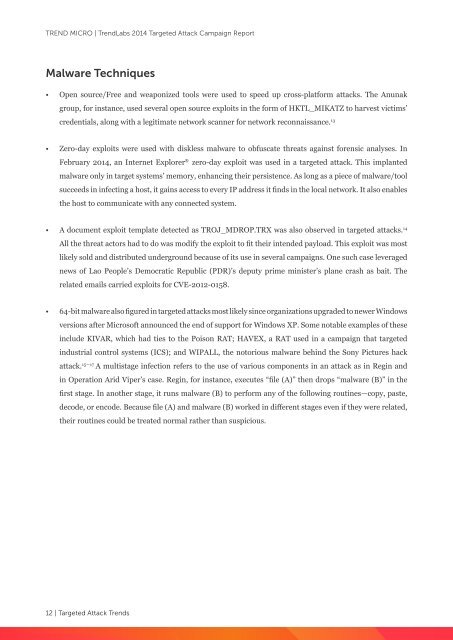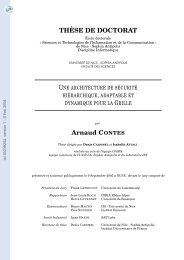Create successful ePaper yourself
Turn your PDF publications into a flip-book with our unique Google optimized e-Paper software.
TREND MICRO | TrendLabs 2014 Targeted Attack Campaign Report<br />
Malware Techniques<br />
• Open source/Free and weaponized tools were used to speed up cross-platform attacks. The Anunak<br />
group, for instance, used several open source exploits in the form of HKTL_MIKATZ to harvest victims’<br />
credentials, along with a legitimate network scanner for network reconnaissance. 13<br />
• Zero-day exploits were used with diskless malware to obfuscate threats against forensic analyses. In<br />
February 2014, an Internet Explorer ® zero-day exploit was used in a targeted attack. This implanted<br />
malware only in target systems’ memory, enhancing their persistence. As long as a piece of malware/tool<br />
succeeds in infecting a host, it gains access to every IP address it finds in the local network. It also enables<br />
the host to communicate with any connected system.<br />
• A document exploit template detected as TROJ_MDROP.TRX was also observed in targeted attacks. 14<br />
All the threat actors had to do was modify the exploit to fit their intended payload. This exploit was most<br />
likely sold and distributed underground because of its use in several campaigns. One such case leveraged<br />
news of Lao People’s Democratic Republic (PDR)’s deputy prime minister’s plane crash as bait. The<br />
related emails carried exploits for CVE-2012-0158.<br />
• 64-bit malware also figured in targeted attacks most likely since organizations upgraded to newer Windows<br />
versions after Microsoft announced the end of support for Windows XP. Some notable examples of these<br />
include KIVAR, which had ties to the Poison RAT; HAVEX, a RAT used in a campaign that targeted<br />
industrial control systems (ICS); and WIPALL, the notorious malware behind the Sony Pictures hack<br />
attack. 15—17 A multistage infection refers to the use of various components in an attack as in Regin and<br />
in Operation Arid Viper’s case. Regin, for instance, executes “file (A)” then drops “malware (B)” in the<br />
first stage. In another stage, it runs malware (B) to perform any of the following routines—copy, paste,<br />
decode, or encode. Because file (A) and malware (B) worked in different stages even if they were related,<br />
their routines could be treated normal rather than suspicious.<br />
12 | Targeted Attack Trends










